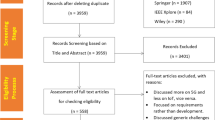Abstract
This paper proposes a versatile analytical model to predict the medium access control (MAC) layer performance metrics (throughput, average MAC service time, successful transmission probability) as well as the energy consumption of wireless personal area networks (WPANs) under all possible transmission modes (unacknowledged, limited and unlimited acknowledged modes) with both saturated and unsaturated traffic patterns. This rigorous analytical approach produces straightforward equations that are used to predict the operational parameters required to optimise the throughput of networks. This paper uses the state-of-the-art IEEE 802.15.4 CSMA-CA protocol to demonstrate the use of the modelling approach. The numerical results obtained from the analytical model are verified through comparison with simulation.














Similar content being viewed by others
References
Vasseur, J., & Dunkels, A. (2010). Interconnecting smart objects with IP: The next internet. Burlington: Morgan Kaufmann.
IEEE Standard for Information Technology. (2003). Telecommunications and information exchange between systems–local and metropolitan area networks specific requirements part 15.4: Wireless medium access control (MAC) and physical layer (PHY) specifications for low-rate wireless personal area networks (LR-WPANs). IEEE Std 802.15.4-2003 (pp. 1–670).
Adams, J. (2006). An introduction to IEEE STD 802.15.4. IEEE aerospace conference.
Miši’c, J., Shafi, S., & Miši’c, V. (2005). The impact of MAC parameters on the performance. Ad Hoc Networks, 3(5), 509–528.
Ling, X., Cheng, L., Mark, J., & Shen, X. (2007). A general analytical model for the IEEE 802.15.4 contention access period. In IEEE wireless communications and networking conference (pp. 316–321).
Ramachandran, I., Das, K. A., & Roy, S. (2007). Analysis of the contention access period of IEEE 802.15.4 MAC. ACM Transactions on Sensor Networks, 3(1), 1–29.
He, J., Tang, Z., Chen, H., & Zhang, Q. (2009). An accurate and scalable analytical model for IEEE 802.15.4 slotted CSMA/CA networks. IEEE Transactions on Wireless Communications, 8(1), 440–448.
Park, T., Kim, T., Choi, J., Choi, S., & Kwon, W. (2005). Throughput and energy consumption analysis of IEEE 802.15.4 slotted CSMA/CA. IEEE Electronics Letters, 41(18), 1017–1019.
Pollin, S., Ergen, M., Ergen, S., Bougard, B., Der Perre, L., Moerman, I., et al. (2008). Performance analysis of slotted carrier sense IEEE 802.15.4 medium access layer. IEEE Transactions on Wireless Communications, 7(9), 3359–3371.
Zhifeng, T., Panwar, S., Daqing, G., & Jinyun, Z. (2006). Performance analysis and a proposed improvement for the IEEE 802.15.4 contention access period. IEEE Wireless Communications and Networking Conference, 4, 1811–1818.
Ling, X., Cheng, Y., Mark, J. W., & Shen, X. (2008). A renewal theory based analytical model for the contention access period of IEEE 802.15.4 MAC. IEEE Transactions on Wireless Communication, 7(6), 2340–2349.
Lee, C., Cho, H., Doh, Y., & Park, N. (2011). Performance modeling and analysis of IEEE 802.15.4 slotted CSMA/CA protocol with ACK mode. AEU-International Journal of Electronics and Communications, 65(2), 123–131.
Shu, F., & Sakurai, T. (2007). Analysis of an energy conserving CSMA-CA. IEEE global telecommunications conference (pp. 2536–2540).
Shu, F., & Sakurai, T. (2011). A new analytical model for the IEEE 802.15.4 CSMA-CA protocol. Computer Networks, 55(11), 2576–2591.
Kim, T., Kim, J., Lee, Park, J., & Choi, B. (2006). Performance analysis of the IEEE 802.15.4 with non-beacon-enabled CSMA/CA in nonsaturated condition. In International conference embedded and ubiquitous computing (pp. 884–893).
Kim, T., Park, J., Chong., H, Kim, K., & Choi, B. (2008). Performance analysis of IEEE 802.15.4 non-beacon mode with the unslotted CSMA/CA. IEEE Communications Letters, 12(4), 238–240.
Buratti, C., & Verdone, R. (2009). Performance analysis of IEEE 802.15.4 non beacon-enabled mode. IEEE Transactions on Vehicular Technology, 58(7), 3480–3493.
Latré, B., DeMil, P., Moerman, I., Van Dierdonck, N., Dhoedt, B., & Demeester, P. (2006). Throughput and delay analysis of unslotted IEEE 802.15.4. IEEE Journal of Networks, 1(1), 20–28.
Goyal, M., Rohm, D., Hosseini, H., Trivedi, K., Divjak, A., & Bashir, Y. (2009). A stochastic model for beaconless IEEE 802.15.4 MAC operation. In International symposium on performance evaluation of computer and telecommunication systems (pp. 199–207).
Cano, J., & Casilari, E., (2011). An empirical evaluation of the consumption of 802.15.4/ZigBee sensor motes in noisy environments. In IEEE international conference on networking sensing and control (pp. 439–444).
Bougard, B., Catthoor, F., Daly, D.C., Chandrakasan, A., & Dehaene, W., (2005). Energy efficiency of the IEEE 802.15.4 standard in dense wireless microsensor networks: Modeling and improvement perspectives. Design, automation and test in Europe conference and exhibition (pp. 196–201).
He, J., Tang, Z., Chen, H., & Wang, S. (2008). An accurate Markov model for slotted CSMA/CA algorithm in IEEE 802.15.4 networks. IEEE Communication Letters, 12(6), 420–422.
Charalambides, C. (2004). Combinatorial methods in discrete distributions. Hoboken, NJ: Wiley series in probability and statistical.
CC2420 Transceiver datasheet. (2006). Available online at: www.mtl.mit.edu/Courses/6.111/labkit/datasheets/CC2420.pdf.
Baz, M., Mitchell, P., & Pearce, D. (2012). Improvements to CSMA-CA in IEEE 802.15.4. In High performance computing and communications conference (pp. 1549–1554).
Yin, Z., et al. (2007). Adaptive contention access suspension in IEEE 802.15.3 MAC. In Fourth international conference on broadband communications, networks and systems (pp. 187–196).
Harchol-Balter, M. (2011). Performance modeling and design of computer systems queuing theory in action. Cambridge: Cambridge University Press.
Łukowski, P. (2011). Paradoxes. Berlin: Springer.
Garg, V. (2010). Wireless communication and networking. Burlington: Morgan Kaufmann.
Author information
Authors and Affiliations
Corresponding author
Rights and permissions
About this article
Cite this article
Baz, M., Mitchell, P.D. & Pearce, D.A.J. Versatile Analytical Model for Delay and Energy Evaluation in WPANs: A Case Study for IEEE 802.15.4 CSMA-CA. Wireless Pers Commun 75, 415–445 (2014). https://doi.org/10.1007/s11277-013-1370-y
Published:
Issue Date:
DOI: https://doi.org/10.1007/s11277-013-1370-y




